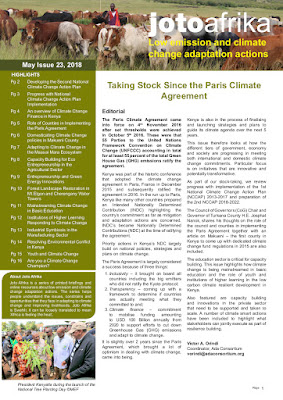By Zoe Tabary
WAJIR, Kenya -
Hamara Hujale tries to keep an eye on two squirming children and a pot of
simmering ugali – a white doughy dish – as she reaches for her buzzing phone.
After speaking
a few words, she hangs up and scribbles in a wrinkled notebook.
"My
driver has found another customer so won't be back for another 30
minutes," she says with a satisfied smile.
Hujale, who lives
in the northeast Kenyan town of Wajir, used to make and sell kitchen utensils,
"mostly to pastoralists who would use them as dowry for their daughters'
weddings".
 |
Hamara Hujale standing infront of her tuk-tuk
in Wajir. TRF/Zoe Tabary
|
"But as
they lost their animals to drought, they had no money left to buy my products. So
I had to find an alternative," she said.
Last year she
secured a loan of 370,000 Kenyan shillings (about $3,560) through Crescent
Takaful Sacco, an Islamic finance institution, and used the money to buy a
tuk-tuk and set up a taxi business in Wajir.
Access to
credit is critical to help communities prepare for and cope with increasingly
frequent climate shocks like droughts and floods, experts say.
However, in
this Kenyan region bordering Somalia, where over 90 percent of the population
is Muslim, few banks or institutions offer financial services that comply with
Islamic law, which bans gambling and speculation, including interest-bearing
loans, said Diyad Hujale, a programme coordinator at Mercy Corps, a charity,
and no relation to Hamara.
To remedy
this, in 2016 a project helped set up the county's first private cooperative
offering financial products in accordance with Islamic principles – such as
interest-free loans, with no fees for late payment.
The
initiative, which is part of the Building Resilience and Adaptation to Climate
Extremes and Disasters (BRACED) programme, is funded by the UK Department for
International Development (DFID) and led by Mercy Corps.
Gladys
Mutisya, manager of the Wajir sacco, said it targets "the unbanked:
pastoralists – who make up half of our clients – farmers, and poorer
communities in general."
"We're
trying to fill a gap that banks and traditional institutions are not able or
willing to fill."
Diyad Hujale
explained that while Sharia-compliant financial services already exist in
Nairobi, the capital, and elsewhere in the country, they are too far away and
expensive for local residents to access – so the BRACED programme supported the
sacco to hire and train staff in Wajir.
PREPARING FOR
SHOCKS
The toughest
challenge in this largely Pastoralist County is prolonged drought, which Hamara
Hujale said, "affects everyone.”
In addition to
her kitchen utensil business, she used to herd over 100 goats - but drought has
claimed many of them.
"I can't
even remember how many have died," she said, bending to smell her pot of
ugali.
Catherine
Simonet of the Overseas Development Institute (ODI), a London-based think tank,
said that families with little or no disposable income are most affected when
drought hits.
Repeated
droughts create "a vicious circle where they not only have no alternative
income if they have lost their harvest, for example, (but) they are also made
more vulnerable to the next shock", she said.
To avoid this
situation, Mutisya said the sacco's clients tend to take out loans in
"good times", such as the harvesting season, when they can most
easily qualify for loans.
They then hold
the cash as easily accessible savings, so that in dry periods they can buy food
and fodder for their animals to survive.
BUSINESSES FOR RESILIENCE
While many
clients use the sacco as a way to boost their cash on hand, others like Hamara
Hujale take out larger loans to set up their own businesses.
That fills a
key gap in the market that is not met by other banks or institutions, Diyad
Hujale said.
"Wajir is
vast and its residents earn very little, so to most investors they don't make
'business sense,'" he said.
Simonet
concurred that the potential for pastoralists to launch businesses is often
underestimated.
"We tend
to only look at pastoralists for example as households, when they're also
producers, businesses, and a hugely untapped source of investment," she
said.
Key to the
sacco's model is trust, said Mutisya. "We don't just blindly give out
loans. We assess the viability of our clients' business ideas and we train them
on issues like accounting."
To minimise
risk, the financial institution often lends money to groups rather than
individuals. "The group's cohesion and reputation acts as a guarantee for
us," Mutisya said.
Hamara Hujale,
who took out a loan on her own, now makes up to 2,000 shillings ($20) per day
from her two businesses – nearly twice as much as when she only sold utensils.
"But I
need the money to repay over 30,000 shillings per month to the sacco," she
said. Her dream, once she has repaid the loan in full, is to "buy a bigger
car to serve as a taxi in rural areas".
REACHING REMOTE AREAS
Since the
sacco opened, about 500 accounts have been created, Diyad Hujale said.
But
"we're only present in a 20km radius around the town, when the entire
county needs us," he said.
He hopes
mobile phone technology will allow the initiative to expand and reach more
people through an online platform, without the need to physically meet with an
agent.
"Currently
the only way to get a loan outside of Wajir town is for our agents to travel to
outside villages, so the operation is currently very costly," he
explained.
Simonet said a
mobile service would make particular sense for pastoralists.
"Pastoralists
not only live in rural areas, they are also constantly on the move. So to them
a physical branch or agents don't make sense," she said.
Article originally published at Building
Resilience and Adaptation to Climate Extremes and Disasters (BRACED).






